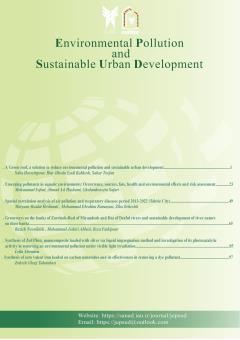سنتز آهن صفر ظرفیتی بارگذاری شده بر روی نانولولههای کربنی و بررسی کارآیی آن در حذف یک آلاینده رنگزا
الموضوعات :
1 - استادیار گروه شیمی، واحد اهر، دانشگاه آزاد اسلامی، اهر، ایران
الکلمات المفتاحية: نانولولههای کربنی, روش باکس-بنکن, آهن صفر ظرفیتی, راکتیو نارنجی 122,
ملخص المقالة :
در این مطالعه آهن صفر ظرفیتی بارگذاری شده بر روی نانولولههای کربنی به عنوان یک نانوجاذب سنتز شد و مورفولوژی آن با میکروسکوپ الکترونی روبشی (SEM) مورد بررسی قرار گرفت. کارایی نانوجاذب برای رنگزدائی و حذف آلاینده رنگ راکتیو نارنجی 122 مورد بررسی قرار گرفت. بهینهسازی متغیرهای عملیاتی مانند مقدار نانوجاذب، غلظت اولیه رنگ و pH به روش طراحی آزمایش بر پایه سطح پاسخ و روش باکس-بنکن انجام شد. حداکثر راندمان حذف در شرایط بهینه %86/16 بدست آمد. با استفاده از روش تحلیل واریانس موثرترین پارامتر شناسایی گردید. برای پیشبینی میزان حذف، مدلی با استفاده از آنالیز رگرسیون چند متغیره ارائه گردید.
[1] Bahrami, M., Amiri, M.J., Dehkhodaie, F., 2021, Effect of different thermal activation on hydroxyapatite to eliminate mercury from aqueous solutions in continuous adsorption system. International Journal of Environmental Analytical Chemistry, 101, 2150.
[2] Lim, L.B.L., Priyantha, N., Fang, X.Y., Mohamad Zaidi, N.A.H., 2017, Artocarpusodoratissimus peel as a potential adsorbent in environmental remediation to remove toxic Rhodamine B dye, Journal of Materials and Environmental Science, 8, 494.
[3] Modirshahla, M., Behnaiady, M.A., Ghazi Tabatabaie, Z., 2006, Kinetic modeling on photooxidative degradation of C.I. Acid Yellow 23 by UV/H2O2 process, Journal of Physical & Theoretical Chemistry, 2, 183.
[4] Aanchal, Barman, S., Basu, S., 2020, Complete removal of endocrine disrupting compound and toxic dye by visible light active porous g-C3N4/H-ZSM-5 nanocomposite, Chemosphere, 241, 124981.
[5] Padervand, M., Lammel, G., Bargahi, A., Mohammad-Shiri, H., 2019, Photochemical degradation of the environmental pollutants over the worm-like Nd2CuO4-Nd2O3 nanostructures, Nano-Structures & Nano-Objects, 18, 100258.
[6] Kumar, A.N., Reddy, C.N., Mohan, S.V., 2015, Biomineralization of azo dye bearing wastewater in periodic discontinuous batch reactor: Effect of microaerophilic conditions on treatment efficiency, Bioresource Technology, 188, 56.
[7] Zahednia, M., Ghazi Tabatabaei, Z., 2018, Investigation of BTEX removal from aqueous solution by single wall carbon nanotubes coated with ZnO, Journal of Water & Wastewater, 29, 1. (in Persian)
[8] Khan, M.A., Ahmad, A., Umar, K., Nabi, S.A., 2015, Synthesis, characterization, and biological applications of nanocomposites for the removal of heavy metals and dyes, Industrial & Engineering Chemistry Research, 54, 76.
[9] Cheikh S’Id, E., Kheribech, A., Degué, M., Hatim, Z., Chourak, R., M’Bareck, C., 2021, Removal of methylene blue from water by polyacrylonitrile co sodium methallylsulfonate copolymer (AN69) and polysulfone (PSF) synthetic membranes, Progress in Color, Colorants and Coatings, 14, 89.
[10] Rezaei, M., Hosseini Shekarabi, F., Varsei, M., Samiee Bayragh, A., 2016, Investigating and comparing removal of Acid Red 37 with electrofenton and electrocoagulation processes. Environmental Sciences, 13, 85.
[11] Adeyemo, A.A., Adeoye, I.O., Bello, O.S., 2017, Adsorption of dyes using different types of clay: A review, Applied Water Science, 7,543
[12] Kasperchik, V.P., Yaskevich, A.L., Bil’Dyukevich, A.V., 2012, Wastewater treatment for removal of dyes by coagulation and membrane processes, Petroleum Chemistry, 52, 545.
[13] Poguberović, P.P., Krčmar, D.M., Dalmacija, B.D., Maletić, S.P., Tomašević-Pilipović, D.D., Kerkez, D.V., Rončević, S.D., 2016, Removal of Ni(II) and Cu(II) from aqueous solutions using 'green' zero-valent iron nanoparticles produced by oak and mulberry leaf extracts. Water Science and Technology, 74, 2115.
[14] Ma, F., Zhao, B., Diao, J., Jiang, Y., Zhang, J., 2020, Mechanism of phosphate removal from aqueous solutions by biochar supported nanoscale zero-valent iron, RSC Advances, 10, 39217.
[15] Fallahnejad, Z., Bakeri, G., Ismail A.F., 2021, Thin film polyamide membranes containing modified manganese dioxide nano-tubes for removal of sodium and copper ions, Iranian Journal of Polymer Science and Technology, 34, 155. (in Persian)
[16] Lee, H.A., Park E., Lee H., 2020, Polydopamine and its derivative surface chemistry in material science: A focused review for studies at KAIST, Adv. Mater., 32, 1907505.
[17] Gupta, V.K., Nayak, A., Agarwal, S., Tyagi I., 2014, Potential of activated carbon from waste rubber tire for the adsorption of phenolics: Effect of pre-treatment conditions, Journal of Colloid and Interface Science, 417, 420.
[18] Robati, D., Mirza, B., Rajabi, M., Moradi O., Tyagi I., Agarwal S., Gupta V.K., 2016, Removal of hazardous dyes-BR 12 and methyl orange using graphene oxide as an adsorbent from aqueous phase, Chemical Engineering Journal, 284, 687.


